原文地址:http://www.cnblogs.com/jacklu/p/5317406.html

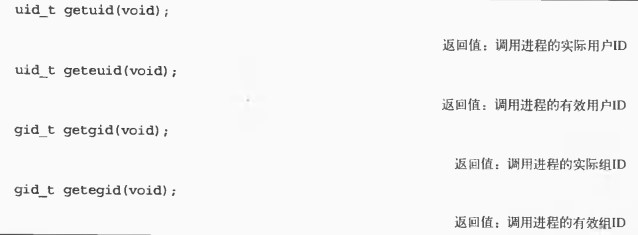 五种进程状态转换如下图所示:
五种进程状态转换如下图所示:
 每个进程的task_struct和系统空间堆栈存放位置如下:两个连续的物理页【《Linux内核源代码情景分析》271页】
每个进程的task_struct和系统空间堆栈存放位置如下:两个连续的物理页【《Linux内核源代码情景分析》271页】
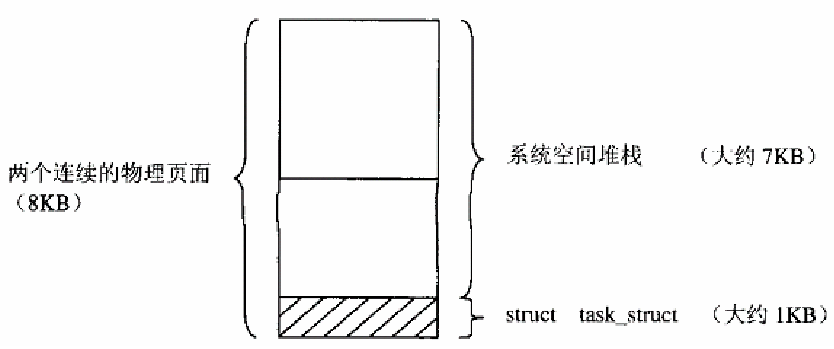 系统堆栈空间不能动态扩展,在设计内核、驱动程序时要避免函数嵌套太深,同时不宜使用太大太多的局部变量,因为局部变量都是存在堆栈中的。
系统堆栈空间不能动态扩展,在设计内核、驱动程序时要避免函数嵌套太深,同时不宜使用太大太多的局部变量,因为局部变量都是存在堆栈中的。

 fork函数时调用一次,返回两次。在父进程和子进程中各调用一次。子进程中返回值为0,父进程中返回值为子进程的PID。程序员可以根据返回值的不同让父进程和子进程执行不同的代码。
一个形象的过程:
fork函数时调用一次,返回两次。在父进程和子进程中各调用一次。子进程中返回值为0,父进程中返回值为子进程的PID。程序员可以根据返回值的不同让父进程和子进程执行不同的代码。
一个形象的过程:
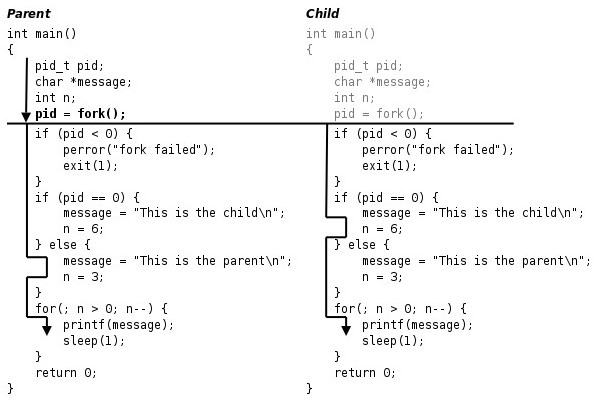 运行这样一段演示程序:
运行这样一段演示程序:
 1 #include
1 #include
2 #include
3 #include
4
5 int main()
6 {
7 pid_t pid;
8 char *message;
9 int n = 0;
10 pid = fork();
11 while(1){
12 if(pid < 0){
13 perror("fork failed
");
14 exit(1);
15 }
16 else if(pid == 0){
17 n--;
18 printf("child's n is:%d
",n);
19 }
20 else{
21 n++;
22 printf("parent's n is:%d
",n);
23 }
24 sleep(1);
25 }
26 exit(0);
27 }
 运行结果:
运行结果:
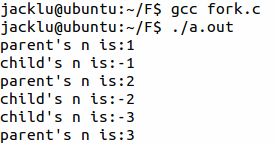 可以发现子进程和父进程之间并没有对各自的变量产生影响。
一般来说,fork之后父、子进程执行顺序是不确定的,这取决于内核调度算法。进程之间实现同步需要进行进程通信。
可以发现子进程和父进程之间并没有对各自的变量产生影响。
一般来说,fork之后父、子进程执行顺序是不确定的,这取决于内核调度算法。进程之间实现同步需要进行进程通信。
 1 #include
1 #include
2 #include
3 #include
4
5 int main()
6 {
7 pid_t pid;
8 char *message;
9 int n = 0;
10 int i;
11 pid = vfork();
12 for(i = 0; i < 10; i++){
13 if(pid < 0){
14 perror("fork failed
");
15 exit(1);
16 }
17 else if(pid == 0){
18 n--;
19 printf("child's n is:%d
",n);
20 if(i == 1)
21 _exit(0);
22 //return 0;
23 //exit(0);
24 }
25 else{
26 n++;
27 printf("parent's n is:%d
",n);
28 }
29 sleep(1);
30 }
31 exit(0);
32 }
 运行结果:
运行结果:
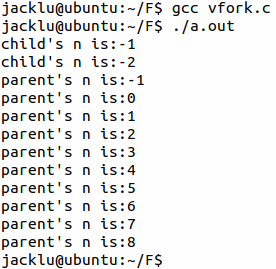 可以发现子进程先被执行,exit后,父进程才被执行,同时子进程改变了父进程中的数据
子进程return 0 会发生什么?
运行结果:
可以发现子进程先被执行,exit后,父进程才被执行,同时子进程改变了父进程中的数据
子进程return 0 会发生什么?
运行结果:
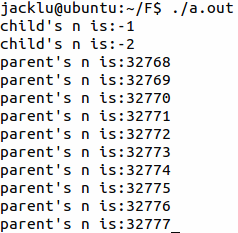 从上面我们知道,结束子进程的调用是exit()而不是return,如果你在vfork中return了,那么,这就意味main()函数return了,注意因为函数栈父子进程共享,所以整个程序的栈就跪了。 如果你在子进程中return,那么基本是下面的过程: 1)子进程的main() 函数 return了,于是程序的函数栈发生了变化。 2)而main()函数return后,通常会调用 exit()或相似的函数(如:_exit(),exitgroup()) 3)这时,父进程收到子进程exit(),开始从vfork返回,但是尼玛,老子的栈都被你子进程给return干废掉了,你让我怎么执行?(注:栈会返回一个诡异一个栈地址,对于某些内核版本的实现,直接报“栈错误”就给跪了,然而,对于某些内核版本的实现,于是有可能会再次调用main(),于是进入了一个无限循环的结果,直到vfork 调用返回 error) 好了,现在再回到 return 和 exit,return会释放局部变量,并弹栈,回到上级函数执行。exit直接退掉。如果你用c++ 你就知道,return会调用局部对象的析构函数,exit不会。(注:exit不是系统调用,是glibc对系统调用 _exit()或_exitgroup()的封装) 可见,子进程调用exit() 没有修改函数栈,所以,父进程得以顺利执行
【《vfork挂掉的一个问题》http://coolshell.cn/articles/12103.html#more-12103】
从上面我们知道,结束子进程的调用是exit()而不是return,如果你在vfork中return了,那么,这就意味main()函数return了,注意因为函数栈父子进程共享,所以整个程序的栈就跪了。 如果你在子进程中return,那么基本是下面的过程: 1)子进程的main() 函数 return了,于是程序的函数栈发生了变化。 2)而main()函数return后,通常会调用 exit()或相似的函数(如:_exit(),exitgroup()) 3)这时,父进程收到子进程exit(),开始从vfork返回,但是尼玛,老子的栈都被你子进程给return干废掉了,你让我怎么执行?(注:栈会返回一个诡异一个栈地址,对于某些内核版本的实现,直接报“栈错误”就给跪了,然而,对于某些内核版本的实现,于是有可能会再次调用main(),于是进入了一个无限循环的结果,直到vfork 调用返回 error) 好了,现在再回到 return 和 exit,return会释放局部变量,并弹栈,回到上级函数执行。exit直接退掉。如果你用c++ 你就知道,return会调用局部对象的析构函数,exit不会。(注:exit不是系统调用,是glibc对系统调用 _exit()或_exitgroup()的封装) 可见,子进程调用exit() 没有修改函数栈,所以,父进程得以顺利执行
【《vfork挂掉的一个问题》http://coolshell.cn/articles/12103.html#more-12103】
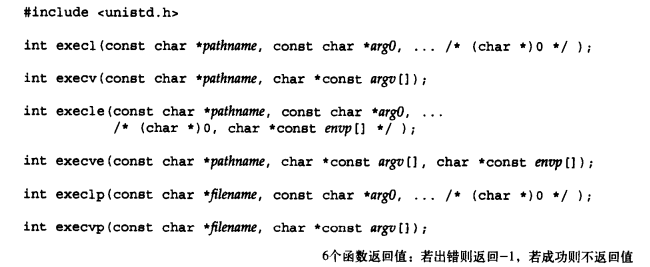 当指定filename作为参数时:
如果filename中包含/,则将其视为路径名。
否则,就按系统的PATH环境变量,在它所指定的各个目录中搜索可执行文件。
*出于安全方面的考虑,有些人要求在搜索路径中不要包括当前目录。
在这6个函数中,只有execve是内核的系统调用。另外5个只是库函数,他们最终都要调用该系统调用,如下图所示:
当指定filename作为参数时:
如果filename中包含/,则将其视为路径名。
否则,就按系统的PATH环境变量,在它所指定的各个目录中搜索可执行文件。
*出于安全方面的考虑,有些人要求在搜索路径中不要包括当前目录。
在这6个函数中,只有execve是内核的系统调用。另外5个只是库函数,他们最终都要调用该系统调用,如下图所示:
 execve的实现由do_execve完成,简化的实现过程如下图:
execve的实现由do_execve完成,简化的实现过程如下图:
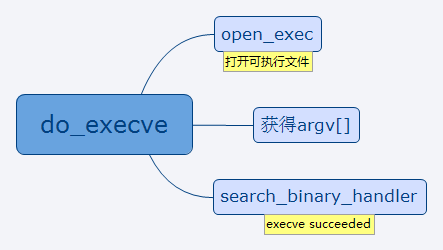
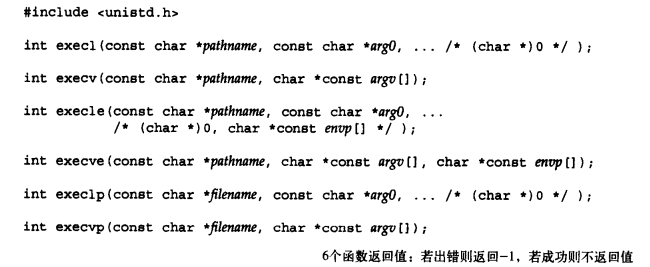 关于这些函数的区别,需要时可以查看《APUE》关于exec函数部分的内容。
运行这样一段演示程序:
关于这些函数的区别,需要时可以查看《APUE》关于exec函数部分的内容。
运行这样一段演示程序:
 1 #include
1 #include
2 #include
3 #include
4
5 char command[256];
6 void main()
7 {
8 int rtn; /*child process return value*/
9 while(1) {
10 printf( ">" );
11 fgets( command, 256, stdin );
12 command[strlen(command)-1] = 0;
13 if ( fork() == 0 ) {
14 execlp( command, NULL );
15 perror( command );
16 exit( errno );
17 }
18 else {
19 wait ( &rtn );
20 printf( " child process return %d
", rtn );
21 }
22 }
23 }
 a.out 是一个打印hello world的可执行文件。
运行结果:
a.out 是一个打印hello world的可执行文件。
运行结果:


 1 #include
1 #include
2 #include
3 #include
4 #include
5
6 int main()
7 {
8 pid_t pid0,pid1;
9 pid0 = fork();
10 if(pid0 < 0){
11 perror("fork");
12 exit(1);
13 }
14 else if(pid0 == 0){
15 sleep(5);
16 exit(0);//child
17 }
18 else{
19 do{
20 pid1 = waitpid(pid0,NULL,WNOHANG);
21 if(pid1 == 0){
22 printf("the child process has not exited.
");
23 sleep(1);
24 }
25 }while(pid1 == 0);
26 if(pid1 == pid0){
27 printf("get child pid:%d",pid1);
28 exit(0);
29 }
30 else{
31 exit(1);
32 }
33 }
34 return 0;
35 }
36
37
38
39 当把第三个参数WNOHANG改为0时,就不会有上面五个显示语句了,说明父进程阻塞了。
40
41
42
43 a.out 的代码如下:
44
45
46 #include
47 void main()
48
49 {
50 printf("hello WYJ
");
51 }
52
53
54
55 process.c的代码如下:
56
57 #include
58 #include
59 #include
60 #include
61 #include
62 #include
63
64 int main()
65 {
66 pid_t pid_1,pid_2,pid_wait;
67 pid_1 = fork();
68 pid_2 = fork();
69 if(pid_1 < 0){
70 perror("fork1 failed
");
71 exit(1);
72 }else if(pid_1 == 0 && pid_2 != 0){//do not allow child 2 to excute this process.
73 if(execlp("./a.out", NULL) < 0){
74 perror("exec failed
");
75 }//child;
76 exit(0);
77 }
78 if(pid_2 < 0){
79 perror("fork2 failded
");
80 exit(1);
81 }else if(pid_2 == 0){
82 sleep(10);
83 }
84 if(pid_2 > 0){//parent
85 do{
86 pid_wait = waitpid(pid_2, NULL, WNOHANG);//no hang
87 sleep(2);
88 printf("child 2 has not exited
");
89 }while(pid_wait == 0);
90 if(pid_wait == pid_2){
91 printf("child 2 has exited
");
92 exit(0);
93 }else{
94 // printf("pid_2:%d
",pid_2);
95 perror("waitpid error
");
96 exit(1);
97
98 }
99 }
100 exit(0);
101 }
 运行结果:
运行结果:
 编写一个多进程程序:该实验有 3 个进程,其中一个为父进程,其余两个是该父进程创建的子进程,其中一个子进程运行“ls -l”指令,另一个子进程在暂停 5s 之后异常退出,父进程并不阻塞自己,并等待子进程的退出信息,待收集到该信息,父进程就返回。
编写一个多进程程序:该实验有 3 个进程,其中一个为父进程,其余两个是该父进程创建的子进程,其中一个子进程运行“ls -l”指令,另一个子进程在暂停 5s 之后异常退出,父进程并不阻塞自己,并等待子进程的退出信息,待收集到该信息,父进程就返回。
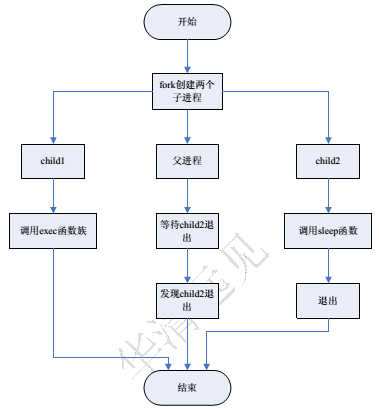
 1 #include
1 #include
2 #include
3 #include
4 #include
5 #include
6 #include
7 int main()
8 {
9 pid_t child1,child2,child;
10 if((child1 = fork()) < 0){
11 perror("failed in fork 1");
12 exit(1);
13 }
14 if((child2 = fork()) < 0){
15 perror("failed in fork 2");
16 exit(1);
17 }
18 if(child1 == 0){
19 //run ls -l
20 if(child2 == 0){
21 printf("in grandson
");
22 }
23 else if(execlp("ls", "ls", "-l", NULL) < 0){
24 perror("child1 execlp");
25 }
26 }
27 else if(child2 == 0){
28 sleep(5);
29 exit(0);
30 }
31 else{
32 do{
33 sleep(1);
34 printf("child2 not exits
");
35 child = waitpid(child2, NULL, WNOHANG);
36 }while(child == 0);
37 if(child == child2){
38 printf("get child2
");
39 }
40 else{
41 printf("Error occured
");
42 }
43 }
44 }
 运行结果:
运行结果:

 1 #include
1 #include
2 #include
3 int main()
4 {
5 pid_t pid;
6 pid = fork();
7 if(pid < 0){
8 printf("error occurred
");
9 }else if(pid == 0){
10 exit(0);
11 }else{
12 sleep(60);
13 wait(NULL);
14 }
15 }
 运行结果:
运行结果:
 ps -ef|grep defunc可以找出僵尸进程
ps -l 可以得到更详细的进程信息
运行结果显示:
ps -ef|grep defunc可以找出僵尸进程
ps -l 可以得到更详细的进程信息
运行结果显示:
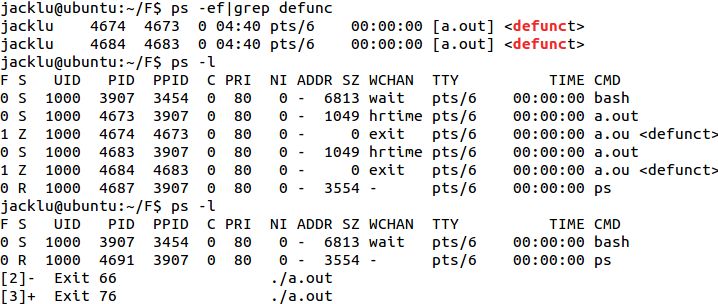 运行两次之后发现有两个Z进程,然后等待一分钟后,Z进程被父进程回收。
其中S表示状态:
O:进程正在处理器运行
S:休眠状态
R:等待运行
I:空闲状态
Z:僵尸状态
T:跟踪状态
B:进程正在等待更多的内存分页
C:cpu利用率的估算值
收集僵尸进程的信息,并终结这些僵尸进程,需要我们在父进程中使用waitpid和wait,这两个函数能够手机僵尸进程留下的信息并使进程彻底消失。
运行两次之后发现有两个Z进程,然后等待一分钟后,Z进程被父进程回收。
其中S表示状态:
O:进程正在处理器运行
S:休眠状态
R:等待运行
I:空闲状态
Z:僵尸状态
T:跟踪状态
B:进程正在等待更多的内存分页
C:cpu利用率的估算值
收集僵尸进程的信息,并终结这些僵尸进程,需要我们在父进程中使用waitpid和wait,这两个函数能够手机僵尸进程留下的信息并使进程彻底消失。
 1 #include
1 #include
2 #include
3 #include
4 #include
5 #include
6 #define MAXFILE 65535
7
8 int main()
9 {
10 int fd,len,i;
11 pid_t pid;
12 char *buf = "tick
";
13 len = strlen(buf);
14 if((pid = fork()) < 0){
15 perror("fork failed");
16 exit(1);
17 }
18 else if(pid > 0){
19 exit(0);
20 }
21 setsid();
22 if(chdir("/") < 0){
23 perror("chdir failed");
24 exit(1);
25 }
26 umask(0);
27 for(i = 0; i < MAXFILE; i++){
28 close(i);
29 }
30 while(1){
31 if((fd = open("/tmp/dameon.log", O_CREAT | O_WRONLY | O_APPEND, 0600)) < 0){
32 perror("open log failed");
33 exit(1);
34 }
35 write(fd, buf, len+1);
36 close(fd);
37 sleep(10);
38 }
39 }
 运行结果:
运行结果:

 1 #include
1 #include
2 #include
3 #include
4 #include
5 #include
6 #include
7 #define MAXFILE 65535
8
9 int main()
10 {
11 int fd,len,i;
12 pid_t pid,child;
13 char *buf = "tick
";
14 len = strlen(buf);
15 if((pid = fork()) < 0){
16 perror("fork failed");
17 exit(1);
18 }
19 else if(pid > 0){
20 exit(0);
21 }
22 openlog("Jack", LOG_PID, LOG_DAEMON);
23 if(setsid() < 0){
24 syslog(LOG_ERR, "%s
", "setsid");
25 exit(1);
26 }
27
28 if(chdir("/") < 0){
29 syslog(LOG_ERR, "%s
", "chdir");
30 exit(1);
31 }
32 umask(0);
33 for(i = 0; i < MAXFILE; i++){
34 close(i);
35 }
36 if((child = fork()) < 0){
37 syslog(LOG_ERR, "%s
", "fork");
38 exit(1);
39 }
40 if(child == 0){
41 //printf("in child
");//can not use terminal from now on.
42 syslog(LOG_INFO, "in child");
43 sleep(10);
44 exit(0);
45 }
46 else{
47 waitpid(child, NULL, 0);
48 //printf("child exits
");//can not use terminal from now on.
49 syslog(LOG_INFO, "child exits");
50 closelog();
51 while(1){
52 sleep(10);
53 }
54 }
55
56 }

进程控制块(PCB)
在Linux中task_struct结构体即是PCB。PCB是进程的唯一标识,PCB由链表实现(为了动态插入和删除)。 进程创建时,为该进程生成一个PCB;进程终止时,回收PCB。 PCB包含信息:1、进程状态(state);2、进程标识信息(uid、gid);3、定时器(time);4、用户可见寄存器、控制状态寄存器、栈指针等(tss) 每个进程都有一个非负的唯一进程ID(PID)。虽然是唯一的,但是PID可以重用,当一个进程终止后,其他进程就可以使用它的PID了。 PID为0的进程为调度进程,该进程是内核的一部分,也称为系统进程;PID为1的进程为init进程,它是一个普通的用户进程,但是以超级用户特权运行;PID为2的进程是页守护进程,负责支持虚拟存储系统的分页操作。 除了PID,每个进程还有一些其他的标识符:
 五种进程状态转换如下图所示:
五种进程状态转换如下图所示:
 每个进程的task_struct和系统空间堆栈存放位置如下:两个连续的物理页【《Linux内核源代码情景分析》271页】
每个进程的task_struct和系统空间堆栈存放位置如下:两个连续的物理页【《Linux内核源代码情景分析》271页】
 系统堆栈空间不能动态扩展,在设计内核、驱动程序时要避免函数嵌套太深,同时不宜使用太大太多的局部变量,因为局部变量都是存在堆栈中的。
系统堆栈空间不能动态扩展,在设计内核、驱动程序时要避免函数嵌套太深,同时不宜使用太大太多的局部变量,因为局部变量都是存在堆栈中的。
进程的创建
新进程的创建,首先在内存中为新进程创建一个task_struct结构,然后将父进程的task_struct内容复制其中,再修改部分数据。分配新的内核堆栈、新的PID、再将task_struct 这个node添加到链表中。所谓创建,实际上是“复制”。 子进程刚开始,内核并没有为它分配物理内存,而是以只读的方式共享父进程内存,只有当子进程写时,才复制。即“copy-on-write”。 fork都是由do_fork实现的,do_fork的简化流程如下图:
fork函数
 fork函数时调用一次,返回两次。在父进程和子进程中各调用一次。子进程中返回值为0,父进程中返回值为子进程的PID。程序员可以根据返回值的不同让父进程和子进程执行不同的代码。
一个形象的过程:
fork函数时调用一次,返回两次。在父进程和子进程中各调用一次。子进程中返回值为0,父进程中返回值为子进程的PID。程序员可以根据返回值的不同让父进程和子进程执行不同的代码。
一个形象的过程:
 运行这样一段演示程序:
运行这样一段演示程序:
 1 #include
1 #include  运行结果:
运行结果:
 可以发现子进程和父进程之间并没有对各自的变量产生影响。
一般来说,fork之后父、子进程执行顺序是不确定的,这取决于内核调度算法。进程之间实现同步需要进行进程通信。
可以发现子进程和父进程之间并没有对各自的变量产生影响。
一般来说,fork之后父、子进程执行顺序是不确定的,这取决于内核调度算法。进程之间实现同步需要进行进程通信。
什么时候使用fork呢?
一个父进程希望子进程同时执行不同的代码段,这在网络服务器中常见——父进程等待客户端的服务请求,当请求到达时,父进程调用fork,使子进程处理此请求。 一个进程要执行一个不同的程序,一般fork之后立即调用execvfork函数
vfork与fork对比: 相同: 返回值相同 不同: fork创建子进程,把父进程数据空间、堆和栈复制一份;vfork创建子进程,与父进程内存数据共享; vfork先保证子进程先执行,当子进程调用exit()或者exec后,父进程才往下执行 为什么需要vfork? 因为用vfork时,一般都是紧接着调用exec,所以不会访问父进程数据空间,也就不需要在把数据复制上花费时间了,因此vfork就是”为了exec而生“的。 运行这样一段演示程序: 1 #include
1 #include  运行结果:
运行结果:
 可以发现子进程先被执行,exit后,父进程才被执行,同时子进程改变了父进程中的数据
子进程return 0 会发生什么?
运行结果:
可以发现子进程先被执行,exit后,父进程才被执行,同时子进程改变了父进程中的数据
子进程return 0 会发生什么?
运行结果:
 从上面我们知道,结束子进程的调用是exit()而不是return,如果你在vfork中return了,那么,这就意味main()函数return了,注意因为函数栈父子进程共享,所以整个程序的栈就跪了。 如果你在子进程中return,那么基本是下面的过程: 1)子进程的main() 函数 return了,于是程序的函数栈发生了变化。 2)而main()函数return后,通常会调用 exit()或相似的函数(如:_exit(),exitgroup()) 3)这时,父进程收到子进程exit(),开始从vfork返回,但是尼玛,老子的栈都被你子进程给return干废掉了,你让我怎么执行?(注:栈会返回一个诡异一个栈地址,对于某些内核版本的实现,直接报“栈错误”就给跪了,然而,对于某些内核版本的实现,于是有可能会再次调用main(),于是进入了一个无限循环的结果,直到vfork 调用返回 error) 好了,现在再回到 return 和 exit,return会释放局部变量,并弹栈,回到上级函数执行。exit直接退掉。如果你用c++ 你就知道,return会调用局部对象的析构函数,exit不会。(注:exit不是系统调用,是glibc对系统调用 _exit()或_exitgroup()的封装) 可见,子进程调用exit() 没有修改函数栈,所以,父进程得以顺利执行
【《vfork挂掉的一个问题》http://coolshell.cn/articles/12103.html#more-12103】
从上面我们知道,结束子进程的调用是exit()而不是return,如果你在vfork中return了,那么,这就意味main()函数return了,注意因为函数栈父子进程共享,所以整个程序的栈就跪了。 如果你在子进程中return,那么基本是下面的过程: 1)子进程的main() 函数 return了,于是程序的函数栈发生了变化。 2)而main()函数return后,通常会调用 exit()或相似的函数(如:_exit(),exitgroup()) 3)这时,父进程收到子进程exit(),开始从vfork返回,但是尼玛,老子的栈都被你子进程给return干废掉了,你让我怎么执行?(注:栈会返回一个诡异一个栈地址,对于某些内核版本的实现,直接报“栈错误”就给跪了,然而,对于某些内核版本的实现,于是有可能会再次调用main(),于是进入了一个无限循环的结果,直到vfork 调用返回 error) 好了,现在再回到 return 和 exit,return会释放局部变量,并弹栈,回到上级函数执行。exit直接退掉。如果你用c++ 你就知道,return会调用局部对象的析构函数,exit不会。(注:exit不是系统调用,是glibc对系统调用 _exit()或_exitgroup()的封装) 可见,子进程调用exit() 没有修改函数栈,所以,父进程得以顺利执行
【《vfork挂掉的一个问题》http://coolshell.cn/articles/12103.html#more-12103】
execve
可执行文件装入内核的linux_binprm结构体。 进程调用exec时,该进程执行的程序完全被替换,新的程序从main函数开始执行。因为调用exec并不创建新进程,只是替换了当前进程的代码区、数据区、堆和栈。 六种不同的exec函数: 当指定filename作为参数时:
如果filename中包含/,则将其视为路径名。
否则,就按系统的PATH环境变量,在它所指定的各个目录中搜索可执行文件。
*出于安全方面的考虑,有些人要求在搜索路径中不要包括当前目录。
在这6个函数中,只有execve是内核的系统调用。另外5个只是库函数,他们最终都要调用该系统调用,如下图所示:
当指定filename作为参数时:
如果filename中包含/,则将其视为路径名。
否则,就按系统的PATH环境变量,在它所指定的各个目录中搜索可执行文件。
*出于安全方面的考虑,有些人要求在搜索路径中不要包括当前目录。
在这6个函数中,只有execve是内核的系统调用。另外5个只是库函数,他们最终都要调用该系统调用,如下图所示:
 execve的实现由do_execve完成,简化的实现过程如下图:
execve的实现由do_execve完成,简化的实现过程如下图:

 关于这些函数的区别,需要时可以查看《APUE》关于exec函数部分的内容。
运行这样一段演示程序:
关于这些函数的区别,需要时可以查看《APUE》关于exec函数部分的内容。
运行这样一段演示程序:
 1 #include
1 #include  a.out 是一个打印hello world的可执行文件。
运行结果:
a.out 是一个打印hello world的可执行文件。
运行结果:

进程终止
正常终止(5种)
从main返回,等效于调用exit 调用exit exit 首先调用各终止处理程序,然后按需多次调用fclose,关闭所有的打开流。 调用_exit或者_Exit 最后一个线程从其启动例程返回 最后一线程调用pthread_exit异常终止(3种)
调用abort 接到一个信号并终止 最后一个线程对取消请求作出响应wait和waitpid函数
wait用于使父进程阻塞,等待子进程退出;waitpid有若干选项,如可以提供一个非阻塞版本的wait,也能实现和wait相同的功能,实际上,linux中wait的实现也是通过调用waitpid实现的。 waitpid返回值:正常返回子进程号;使用WNOHANG且没有子进程退出返回0;调用出错返回-1; 运行如下演示程序
 1 #include
1 #include  运行结果:
运行结果:
 编写一个多进程程序:该实验有 3 个进程,其中一个为父进程,其余两个是该父进程创建的子进程,其中一个子进程运行“ls -l”指令,另一个子进程在暂停 5s 之后异常退出,父进程并不阻塞自己,并等待子进程的退出信息,待收集到该信息,父进程就返回。
编写一个多进程程序:该实验有 3 个进程,其中一个为父进程,其余两个是该父进程创建的子进程,其中一个子进程运行“ls -l”指令,另一个子进程在暂停 5s 之后异常退出,父进程并不阻塞自己,并等待子进程的退出信息,待收集到该信息,父进程就返回。

 1 #include
1 #include 运行结果:
运行结果:

init进程成为所有僵尸进程(孤儿进程)的父进程
僵尸进程
在进程调用了exit之后,该进程并非马上就消失掉,而是留下了一个成为僵尸进程的数据结构,记载该进程的退出状态等信息供其他进程收集,除此之外,僵尸进程不再占有任何内存空间。 子进程结束之后为什么会进入僵尸状态? 因为父进程可能会取得子进程的退出状态信息。 如何查看僵尸进程? linux中命令ps,标记为Z的进程就是僵尸进程。 执行下面一段程序: 1 #include
1 #include  运行结果:
运行结果:
 ps -ef|grep defunc可以找出僵尸进程
ps -l 可以得到更详细的进程信息
运行结果显示:
ps -ef|grep defunc可以找出僵尸进程
ps -l 可以得到更详细的进程信息
运行结果显示:
 运行两次之后发现有两个Z进程,然后等待一分钟后,Z进程被父进程回收。
其中S表示状态:
O:进程正在处理器运行
S:休眠状态
R:等待运行
I:空闲状态
Z:僵尸状态
T:跟踪状态
B:进程正在等待更多的内存分页
C:cpu利用率的估算值
收集僵尸进程的信息,并终结这些僵尸进程,需要我们在父进程中使用waitpid和wait,这两个函数能够手机僵尸进程留下的信息并使进程彻底消失。
运行两次之后发现有两个Z进程,然后等待一分钟后,Z进程被父进程回收。
其中S表示状态:
O:进程正在处理器运行
S:休眠状态
R:等待运行
I:空闲状态
Z:僵尸状态
T:跟踪状态
B:进程正在等待更多的内存分页
C:cpu利用率的估算值
收集僵尸进程的信息,并终结这些僵尸进程,需要我们在父进程中使用waitpid和wait,这两个函数能够手机僵尸进程留下的信息并使进程彻底消失。
守护进程Daemon
是linux的后台服务进程。它是一个生存周期较长的进程,没有控制终端,输出无处显示。用户层守护进程的父进程是init进程。 守护进程创建步骤: 1、创建子进程,父进程退出,子进程被init自动收养;fork exit 2、调用setsid创建新会话,成为新会话的首进程,成为新进程组的组长进程,摆脱父进程继承过来的会话、进程组等;setsid 3、改变当前目录为根目录,保证工作的文件目录不被删除;chdir(“/”) 4、重设文件权限掩码,给子进程更大的权限;umask(0) 5、关闭不用的文件描述符,因为会消耗资源;close 一个守护进程的实例:每隔10s写入一个“tick” 1 #include
1 #include 运行结果:
运行结果:

 1 #include
1 #include